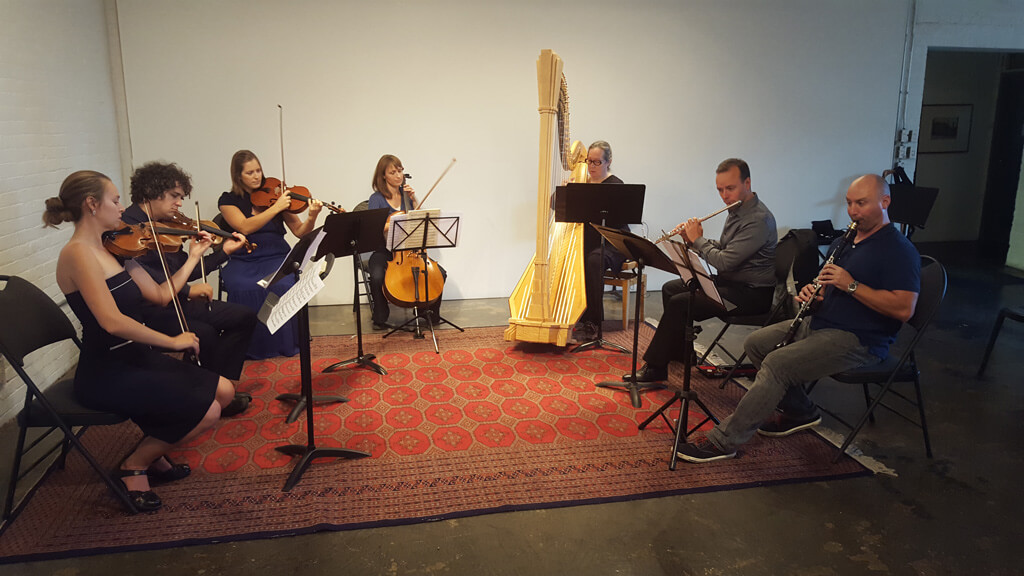
Westwood Concerts with Burning Bridge String Quartet, Sharlene Wallace, Kenneth Hall and Michael Westwood at Gallery 345, Oct. 5.
When you buy a baking or cooking ingredient such as flour, chocolate or even a vegetable, it will often come with a recipe attached or a link to a website with recipes. These recipes are usually quite dependable because the vendor wants you to enjoy the ingredient and return to purchase more. It’s a clever merchandising technique that has resulted in the wide distribution of such recipe classics as Toll House Cookies (by Nestle, whose produce is the chocolate chips).
Instrument companies have exploited the same device, with equally delicious results. In 1905 the Erard company commissioned Maurice Ravel to compose a piece that would showcase their newfangled double-action pedal harp — an alternative to the cross-strung harp. Introduction and Allegro for harp, flute, clarinet and string quartet, which premiered in Paris in 1907 was the result. If that performance matched the presentation at Gallery 345 on Wednesday evening, sales for the Erard harp should have skyrocketed.
Just as Nestle combines the chocolate chips they are promoting with a blend of other enhancing ingredients, Ravel wisely surrounded the harp with a medley of luxurious sounds that allowed the harp to show off its expressive range, from mystical to mysterious to celestial to piquant to serene to haunting. In this respect, it is not exactly a mini-concerto for harp with accompanying instruments, but an ensemble piece, until the culminating cadenza, which is riveting.
Although the piece is called an introduction, at this concert it was performed as the last number, by which time we were well acquainted with the superlative skills of harpist Sharlene Wallace who had already indulged us with a rich medley of 20th-century, contemporary and traditional compositions for solo harp as well duets for harp and flute and harp and clarinet. This included the world premiere of Fantasy for Clarinet and Harp, by Colin Eatock who was in attendance. His preliminary comments about the challenge of writing for an instrument that is played with the hands and the feet, which operate seven pedals, increased my appreciation of his work and the performer’s virtuosity enormously. Two compositions by Wallace gave the harp’s voice a mellow tenderness as well as a jazzy resilience. She also performed on both a pedal harp and a Celtic harp, which has a set of levers instead of pedals, treating us to a greater range of the instrument’s colours.
At an intimate venue such as Gallery 345, which is in a converted loft, the audience sits on the same plane as the performers — a pleasant change from looking up at them. The visual aspect of an instrumental performance may be secondary to the sound but just as the dancer cannot be separated from the dance, the physical, choreographic artistry of the musicians is a significant component of the sounds they produce. This is especially true of the harpist, who is usually not as visible as Wallace was. The harpist’s posture, leaning forward with arms extended on both sides of the strings, face to one side, hands stroking and fingers plucking, creates the sense that the harp is being held in a loving embrace. Wallace also bobbed her head in rhythm with her playing at times, creating the illusion that she and the harp were partners agreeing with each other in mutual dialogue.
The evening was a star turn for the harp, but the rest of the ensemble held its own. The Burning Bridge String Quartet opened the program with one of Brahms’ three quartets, Opus 51 No. 2 in A-minor, a demanding half-hour piece with a great many qualifications from the composer, who wanted the movements to be “non-troppo” or “quasi” or “moderato” or “non assai”. They were more than equal to these nuances, and especially in the finale, “Allegro non assai” demonstrated why they call themselves burning.
Like the small but essential amount of baking soda in the Toll House cookies, Michael Westwood on clarinet and Kenneth Hall on flute added the lifting sounds that elevated their pieces. The expression “I’ve got it in my pocket”, meaning that something is under control, or fully mastered, took on new meaning when Hall pulled his fife out of his pants pocket, after playing on the modern flute.
Westwood Concerts has three more concerts in their 2016–17 season that showcase an intriguing collection of musicians from home and abroad, who have studied at the finest schools with legendary teachers, as well as a stimulating combination of original compositions and beloved classics. Hearing these works in a relaxed venue, for an affordable price, is an opportunity that music lovers in Toronto are lucky to have.
#LUDWIGVAN
Want more updates on Toronto-centric classical music news and review before anyone else finds out? Get our exclusive newsletter here and follow us on Facebook for all the latest.



